The 6 Core Components of the Global Digital Document Ecosystem
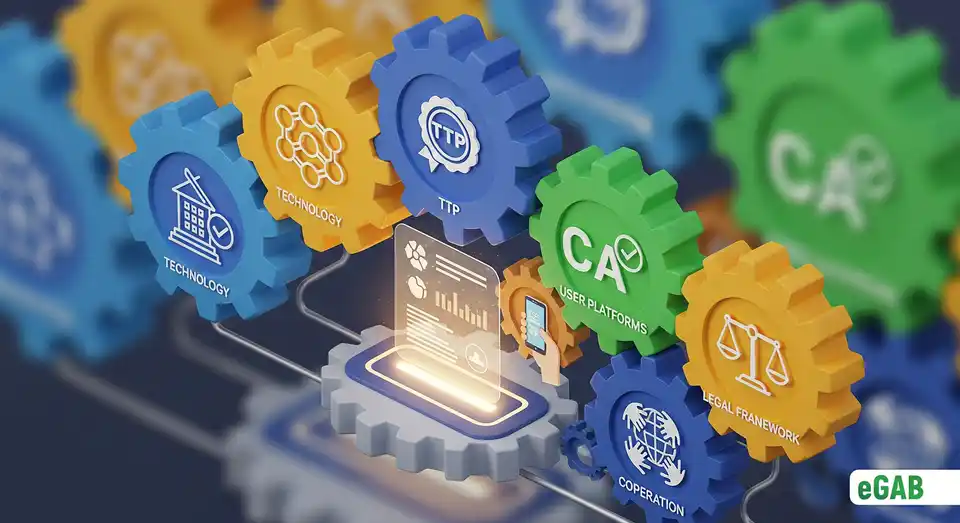
 Author:
Artem Grigoriev
Author:
Artem Grigoriev
Have you ever wondered what holds a massive, worldwide system for digital documents together? It's a fair question. A truly functional, global network isn’t built on a single piece of software. It's not based on just one brilliant idea.
Instead, its power comes from a carefully designed global digital document ecosystem. Think of it like a framework where multiple interconnected components must work together in perfect harmony.
To get it, don't just think about a single app. Think more about building a secure international bank. You need more than just a strong vault. You also need trusted bankers, an official currency, and rules that everyone agrees to follow.
This article will break down the six essential components of this very digital credentialing ecosystem . We'll show you exactly what makes a digital document ecosystem work . You'll see how these foundational pillars, which support the program's core definition and purpose, combine to create a network that is trusted, seamless, and truly global.
📘 This post is part of our comprehensive guide to "The Global Digital Credentials Management Program". Explore it to find answers to all your questions ;)
What Is the Technological Foundation?
So, what's the engine behind The Global Digital Credentials Management Program? This isn't just a good idea-it's a complete system powered by some seriously robust technology. This technological foundation for digital credentials is what turns secure, global recognition from a dream into a reality. The system's backbone is built on a platform designed for ultimate trust: typically, a blockchain or another type of distributed ledger technology (DLT). Using blockchain for educational credentials , in particular, delivers a new level of integrity that traditional paper and digital files simply can't match.
So, how does blockchain secure educational records? The easiest way to think of this technology is as a digital notary that’s online 24/7 and operates across the globe. Its only job is to make sure every single credential record is immutable, transparent, and secure.
Let's break that down. Once we record your diploma on the blockchain, it can't be secretly changed or altered. That’s what immutable means. The verification process is also open and clear for any authorized party to see, which is what makes it transparent . And finally, powerful cryptography protects it, keeping it secure . This provides an unmatched level of data security , ensuring that your sensitive personal and academic information is shielded from all kinds of threats.
However, it's critical to understand that not all blockchains are created equal. Simply "using blockchain" isn't enough to guarantee success. Choosing the right type of blockchain optimized for educational needs is absolutely vital. It’s the only way to create a system that works effectively and efficiently in the real world. After all, you wouldn't use a scooter engine to power a freight train, and the same logic applies here.
For everything to function correctly, a few key factors have to be perfect. First, let's talk about energy efficiency. You can forget the stories about massive energy consumption. Modern systems use smart consensus models like Proof-of-Stake that are both lean and green. Then there's scalability . The network must handle millions of requests from students, schools, and employers all at once, without ever grinding to a halt. You also need transaction finality , which is a rock-solid guarantee. Once a credential is issued and recorded, that transaction can never be undone or reversed. Finally, you need clear governance models . These models set the rules for how the network is managed and updated, making sure it stays fair and functional for everyone.
And this isn't just a theoretical wish list. A perfect example of this technology in action right now is the European Blockchain Services Infrastructure (EBSI) . This massive public sector initiative is building a Europe-wide, GDPR-compliant blockchain specifically for public services like the European Digital Credentials for Learning. This project is definitive proof that this kind of secure, efficient, and user-focused infrastructure isn't a distant dream-it's the foundation for the future of digital documents.
This technological foundation is what makes the whole system trustworthy. It’s the critical difference between a simple, editable PDF of a diploma and a truly secure, verifiable digital asset that you control. This tech ensures that when an employer or university verifies your credentials, they can be 100% certain.
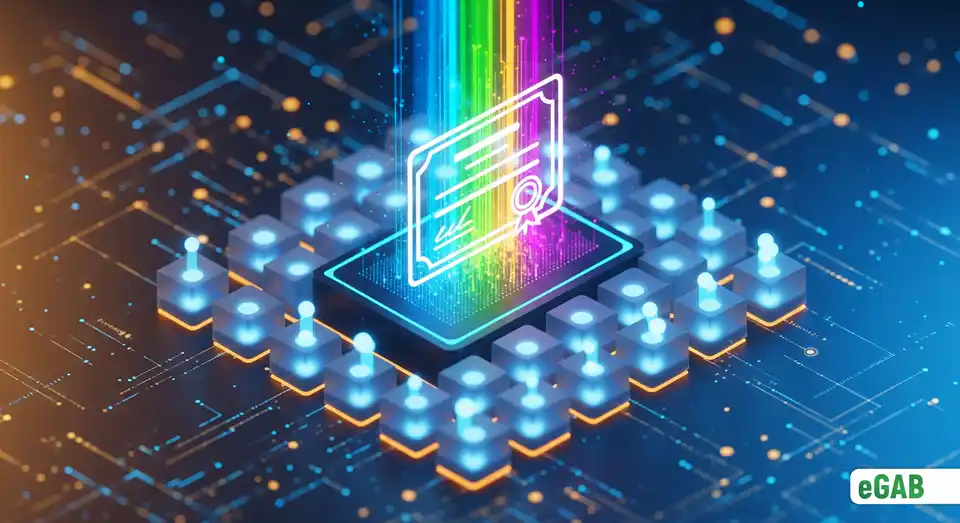
What Is the Role of a Trusted Third Party (TTP)?
So, what exactly is a Trusted Third Party (TTP) in the world of digital verification? In a decentralized world, information is everywhere, which raises a huge question: who do you trust? When anyone can create a digital document, how can you be sure it's real? That’s where the quiet hero of the system, the Trusted Third Party (TTP) , steps in. Understanding the role of trusted third parties (TTP) is the key to seeing how we build digital trust on a global scale.
Think of a TTP as a notary public for the digital age. When you get a paper document notarized, what happens? An official confirms your identity, watches you sign, and adds their official stamp of approval. That stamp is a universal symbol of trust. A TTP does the same kind of job, but on a global, digital scale. It's an accredited organization that acts as a neutral referee, and its entire job is to ensure authenticity and verification . It doesn't just guarantee a document is authentic-more importantly, it ensures the legitimacy of its issuer is recognized worldwide.
These aren't new organizations we've just dreamed up. In fact, many TTPs are organizations you already know and trust. Take accreditation bodies like ENQA (the European Association for Quality Assurance in Higher Education) . These groups already spend their days verifying the quality and standards of universities. By stepping into the TTP role, they're just extending that same verification work to the digital credentials those universities issue. They are, in effect, becoming digital-era notaries.
This adds an essential layer of confidence to the whole system. For TTPs to work, their own rules have to be crystal clear. Their operational standards and liability must be strictly defined. This way, everyone-from employers to admissions officers-knows a TTP's approval means something and is backed by real accountability. Without this foundation, the trust disappears. TTPs are the vital link that ensures a digital degree from one country is instantly accepted in another, all because a recognized TTP has vouched for it.
A TTP is the essential bridge connecting human trust with digital technology. The technology ensures a document can't be forged, but the TTP ensures the organization that created it is real and reputable in the first place. It’s this powerful combination that creates a system that’s both technologically secure and institutionally trustworthy.
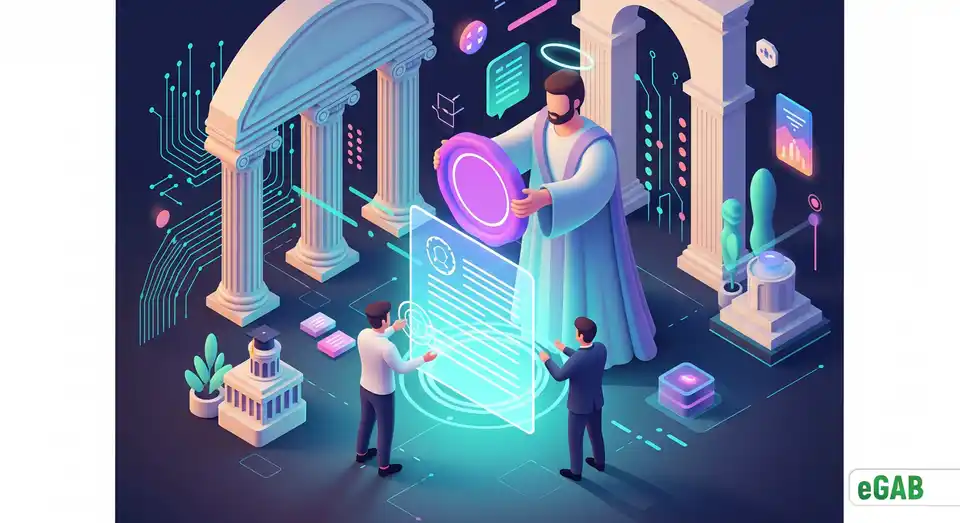
How Are Credential Issuers (CAs) Certified?
In a global system where anyone can claim to be an educational provider, who is allowed to issue official digital credentials? How do you actually know who to trust? This is one of the most important questions The Global Digital Credentials Management Program answers. Before a university can issue a single digital credential on the network, it must pass a thorough verification process. This strict process, known as credential issuer certification , requires it to become a legitimate Certification Authority (CA) . Let's be crystal clear: this isn't just a suggestion-it's a strict, non-negotiable rule.
Think of it like getting a license to practice medicine. A doctor can't just print a certificate and start seeing patients; they first have to be certified by an official medical board that confirms their qualifications are real. Applying this same logic to educational institutions, The Global Digital Credentials Management Program requires robust procedures . These steps are in place to prove an organization has the legal standing to grant its qualifications and confirms they have the authority to do what they claim. This vital step ensures that the issuers themselves are as credible as the documents they create.
So, how does this verification actually work? The process is far more than a simple checkbox; it involves a deep and careful integration with official databases. We're talking about the national or regional databases of accredited educational providers. These databases, often managed by a country's Ministry of Education or a similar body, serve as the ultimate source of truth. To confirm an institution's legitimacy, the system cross-references it against these records. The rule is simple: if a university isn't on that government-approved list, it absolutely cannot join the network.
This verification step is critical, acting as a powerful gatekeeper and the primary line of defense. It successfully stops unaccredited entities, including fraudulent "diploma mills," from ever gaining access by blocking them from the trusted ecosystem. This is how the entire system maintains its integrity. It ensures that only verified institutions can issue credentials, which in turn gives employers and other schools complete confidence that every single digital document they receive is both authentic and meaningful.
This rigorous certification process is precisely what gives your digital credentials their inherent power. When you share your verified degree, an employer isn't just trusting you; they're trusting a global system that has already done the hard work of vetting your university. This built-in layer of trust is key. It's what makes your achievements instantly recognizable and highly respected anywhere in the world.
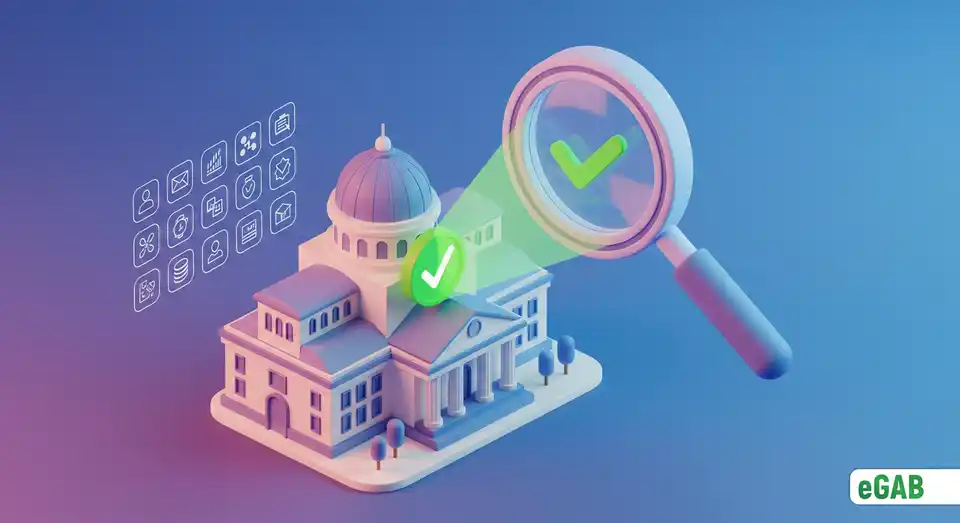
How Do Users Interact with the System?
A revolutionary global system sounds great, but what’s it actually like to use? The best technology should feel invisible, and that’s exactly what we aimed for. A premium user experience (UX) is the guiding principle behind the entire ecosystem, which we built around simple, user-friendly trusted platforms . These platforms are what make interacting with your credentials feel both effortless and totally secure.
So, let's talk about the institutions , like universities and colleges. For them, the system comes to life through intuitive online dashboards. Picture a clean, straightforward portal where you can securely issue digital diplomas and manage student records with just a few clicks. We designed the system to plug right into your existing setups. This innovative approach gets rid of those old-school administrative headaches, so there's no more printing, mailing, and manually verifying documents.
This brings us to a key question for the individual: How do users manage their digital credentials? At the heart of it all are the students and graduates . You get your valuable credentials delivered to a secure digital portfolio or wallet. This digital wallet / digital portfolio becomes your lifelong home for your achievements, accessible on your phone or computer through intuitive user platforms for digital wallets . It acts as your personal, verified showcase of accomplishments. From this one central hub, you have complete control. It lets you store your degrees, certificates, and other qualifications, and you can share them with whomever you choose-whether that's an employer, another university, or a licensing board. All it takes is a simple link or a tap. It’s truly your career, right in your pocket.
And what about the employers and other verifiers ? For them, the process is all about speed and confidence. Instead of waiting days or even weeks for a background check, they get instant access. We provide them with efficient tools for quick and easy verification. They might receive a secure link or scan a QR code from a candidate, and within seconds, they can confirm the credential is 100% authentic because it comes directly from the source. This streamlined process eliminates doubt and speeds up hiring.
Here's the bottom line: none of this works unless it works for everyone. That’s why accessibility for all users is a non-negotiable cornerstone, ensuring everyone-from institutions and students to employers-can use the system effectively. This, of course, includes those with disabilities. True global access means equitable access. To make this a reality, these platforms are built to the highest standards, like the Web Content Accessibility Guidelines (WCAG) . This commitment ensures that using the system is a seamless experience for every single person.
A powerful system is only as good as its user experience. The ecosystem truly puts people first. It focuses on simple interfaces for institutions, gives graduates total control over their digital wallets, and offers instant verification for employers. This intentional design ensures that the technology serves us, and not the other way around.
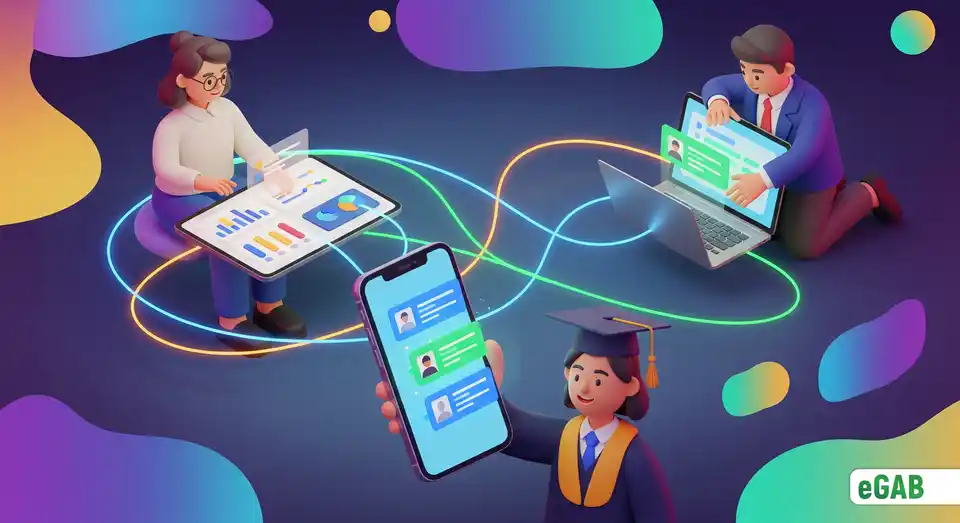
Why Is International Cooperation Essential?
To really get the challenge, let's use a practical example. Imagine you're tasked with building a global railway system. What would happen if each country insisted on using its own track width? A train leaving Paris would stop dead at the Spanish border, completely unable to continue. This railway problem is the exact challenge a global credentialing system faces without teamwork. You simply can't build a functional, worldwide network in a bubble. Its success hinges on active international cooperation , which is one of the program's six key objectives. This cooperation must bring together governments, educational institutions, tech companies, and standards organizations.
So, why is international cooperation needed for digital documents? The main goal of this collaboration is straightforward: to get everyone speaking the same digital language. Technically, this is called achieving interoperability -the ability for different systems to connect and seamlessly exchange information. Getting there means agreeing on common technical standards . It also requires consistent data formats and a unified set of operating rules. This foundational teamwork is exactly what international cooperation for digital standards is all about. Once everyone is working from the same blueprint, everything changes. A digital certificate issued in Tokyo becomes instantly readable and trusted by an employer in Toronto. A system like this gets rid of the friction, delays, and confusion that currently bog down the international verification process. The outcome is a seamless and efficient ecosystem where everyone wins.
A central force driving this push for unity is the Groningen Declaration Network (GDN) . You can think of the GDN as the main diplomatic hub for academic credentials. It's an international consortium that brings all key stakeholders to the table. This group includes everyone, from universities to government agencies, united by a single mission: to champion digital student data portability on a global scale. The GDN provides a dedicated space for dialogue and building consensus. This is a crucial function, as it helps ensure that the digital highway for credentials has on-ramps and off-ramps that work for every single country.
Without this essential cooperation, we'd have a major problem. We would simply end up with a collection of isolated digital islands, which are no more effective than the paper-based systems we use today. It’s this collective agreement to build these crucial bridges that turns a global network from a mere possibility into a reality-a network that's genuinely trustworthy, not just a theoretical concept.
International cooperation is far from just a "nice-to-have" feature. It's the core engine that powers both trust and interoperability . When major global players all agree on a single standard, it gives the system legitimacy. This provides the universal acceptance needed for employers and institutions to rely on it worldwide, without a second thought.
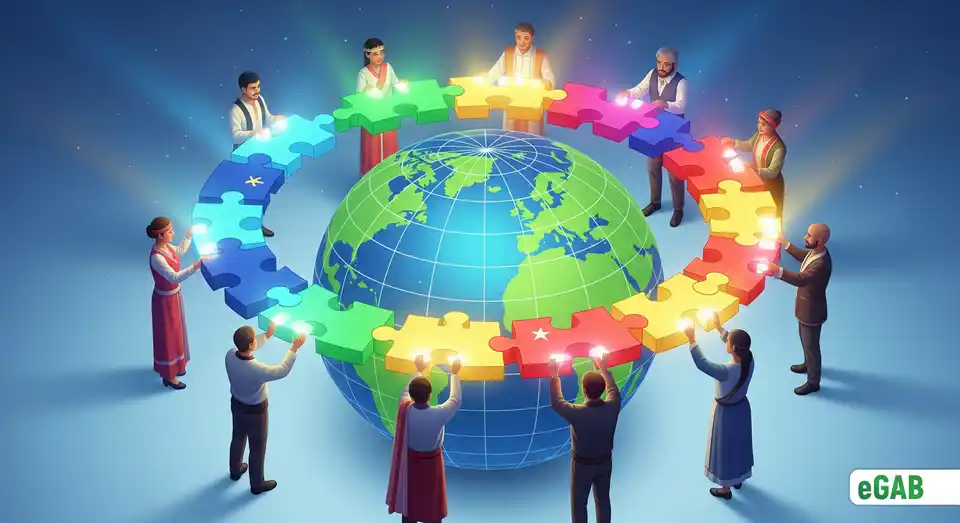
What Legal Frameworks Are Required?
Powerful technology is only half the battle. For it to truly change the world, it needs the rule of law to back it up, and The Global Digital Credentials Management Program is no different. For this global system to work, it needs a supportive regulatory framework built upon the program's foundational principles. This is what gives digital educational documents their official legal force and status . Let's be honest: without this legal foundation, a digital diploma is just a collection of pretty pixels. This highlights the deep-rooted problems of paper and digital documents that the program was designed to fix. Our main goal is to make sure these new credentials aren't just accepted, but are seen by the law as equal or even superior to the traditional paper certificates we’ve used for centuries.
This naturally leads to a big question we hear all the time: are digital diplomas legally valid? The answer depends entirely on the laws currently on the books. So, what does it take to build this legal structure? It starts with the basics: adapting and developing legislation. Think about it: lawmakers wrote most existing laws long before anyone even dreamed up technologies like blockchain. This means we need a complete legal framework for digital documents that carefully handles their creation, validation, and recognition across borders. This puts a big task in front of governments and international bodies. They have to either update old rules or write entirely new ones. These new regulations must specifically recognize and empower digital credentials, because this legal work is the foundation of the entire system.
Of course, a huge piece of this puzzle is protecting your personal information. Any system that handles sensitive data has to guarantee strict compliance with data privacy laws like GDPR (General Data Protection Regulation). This isn't just a friendly suggestion-it's an absolute must. The legal framework must ensure your data is handled with the utmost care, always respecting your consent and privacy rights. This also brings up complex topics like data sovereignty -the idea that your data is governed by the laws of the country where it’s stored. The Global Digital Credentials Management Program's legal structure must create clear rules for these cross-border data flows, making sure a credential from one country can be verified in another without breaking any laws.
Finally, the system needs to define the legal standing of its own technology. This means officially recognizing blockchain-recorded evidence and treating digital signatures as legally binding. For instance, when a university issues a degree on the blockchain, the law has to recognize that transaction as an undeniable, tamper-proof record. It’s this legal validation that gives the entire digital ecosystem its authority and makes it trustworthy.
Think of the legal framework as the official "seal of approval" from the world's governments. It's what separates an interesting tech demo from a globally recognized system. Without these laws, employers would have no reason to accept digital credentials. The dream of a seamless, borderless exchange of achievements would remain just that-a dream.
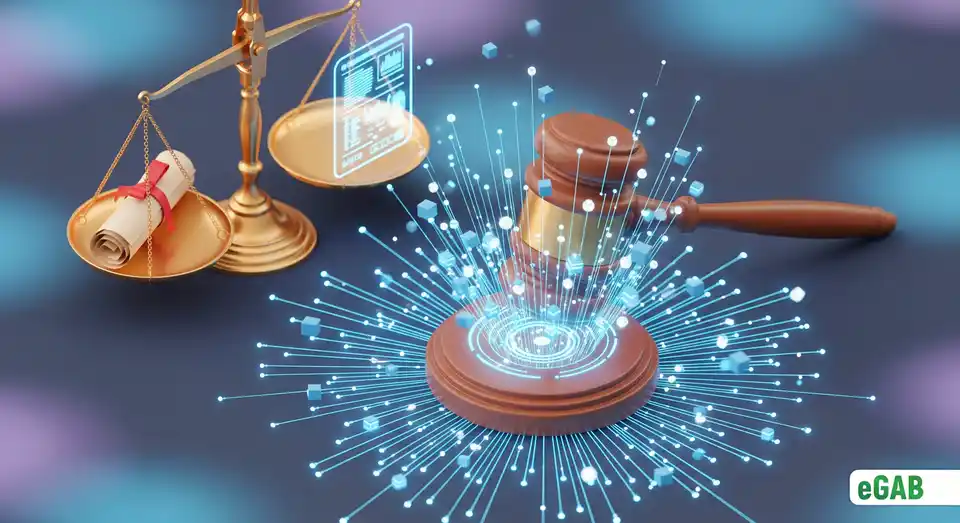
Summary: The Pillars of a Global Ecosystem
So, how does a massive, worldwide system for digital documents actually work? With so many moving parts, what makes a digital document ecosystem work ? The answer isn't a single piece of software. Instead, it’s a global digital document ecosystem carefully built on six essential components . All of these pillars within the digital credentialing ecosystem are designed to work together perfectly. When you combine these components of digital document exchange , as demonstrated in a real-world case study, you build a foundation of trust that makes a truly connected, global future possible.
To get a better handle on this, think of it like building a secure, global bank. You wouldn't just need a strong vault; you'd also need trusted bankers and an official currency. On top of that, you'd need a set of rules that everyone agrees to follow. It's the exact same idea at play here.
The first pillar is, of course, a reliable technology. The entire system runs on a specialized digital ledger, which often uses blockchain technology. This ledger acts as your completely unchangeable record book. Once a credential is created and verified, it's locked in securely with a special cryptographic seal. This innovative process makes it virtually impossible for anyone to tamper with the record, and it provides a level of security that traditional paper documents could never match.
But let's be real-technology alone isn't enough to make the system work. You also need the second pillar: Trusted Third Parties (TTPs). Think of them as the digital notaries of the ecosystem. They are completely neutral, verified organizations whose main job is to confirm a document's or signature's authenticity, guaranteeing its legitimacy to anyone who needs to check it.
Working hand-in-hand with them is the third pillar, the Certified Issuers (CAs). This is a critical quality-control step, ensuring that only properly accredited and recognized institutions-like a verified university or a professional licensing board-have the authority to issue official credentials. This crucial step stops just anyone from creating a "degree" and makes sure every single document within the system comes from a completely legitimate source.
Now, all this powerful technology would be useless if no one could actually use it. That's precisely why user-friendly platforms are the fourth pillar. The main goal here is to make managing your credentials incredibly easy-it should be as simple as using your mobile banking app. These platforms are designed to give you a simple, secure way to access, store, and easily share your achievements. This approach puts you in full control of your own information, with no computer science degree required.
Of course, for any system to be truly global, everyone has to play by the same rules. This brings us to the fifth pillar: international cooperation. For this project to succeed, everyone has to work together. Countries, educational bodies, and major employers all need to collectively set and follow common standards. This level of cooperation ensures that a digital degree from one country is instantly recognized and trusted in another, breaking down the frustrating barriers that so often slow down global mobility for students and professionals.
Finally, none of this can work without a legal framework. This is the vital pillar that gives digital credentials their official, real-world power. To be effective, governments and legal systems have to officially recognize these secure digital documents, treating them as just as valid-if not more so-than their paper-and-ink counterparts. This crucial step creates a new asset class known as verifiable digital credentials , which are trusted by default. Indeed, this essential legal recognit
This is the final piece of the puzzle, cementing the trust and real-world value of the entire ecosystem.
So, what is the difference between a PDF diploma and a verifiable credential? The answer is in how these six pillars work together. A simple PDF is an isolated file that's incredibly easy to fake. In contrast, a verifiable credential is a secure asset that's fully backed by technology, trusted parties, certified issuers, user-friendly platforms, international agreements, and legal recognition.
These six pillars are more than just technical specs; they’re a complete rethinking of how we prove our skills and knowledge. The system combines tamper-proof technology with human-led verification and global agreements. Ultimately, this creates a single source of truth for your achievements-one that's secure, universally understood, and entirely under your control.
➡️ Where does the value lie? You've examined the technical building blocks. Now, see the direct impact this has on students, employers, and institutions. Find out who benefits from the GDCP advantage.
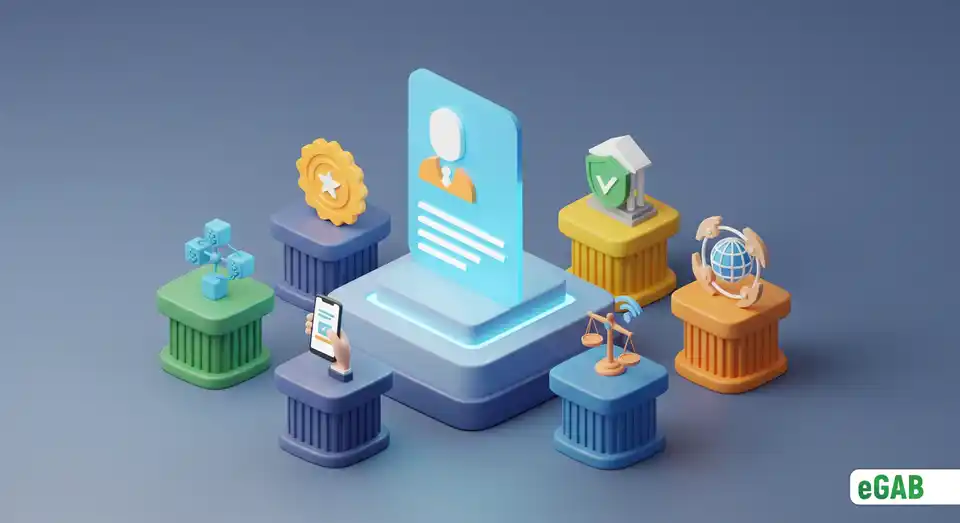
Who Benefits from Digital Credentials? The GDCP Advantage
The 12 Foundational Principles of the GDCP
The 6 Core Objectives of the GDCP Program
Why Paper Diplomas Are Obsolete: The GDCP Solution
The GDCP: Definition, Principles, and Purpose
